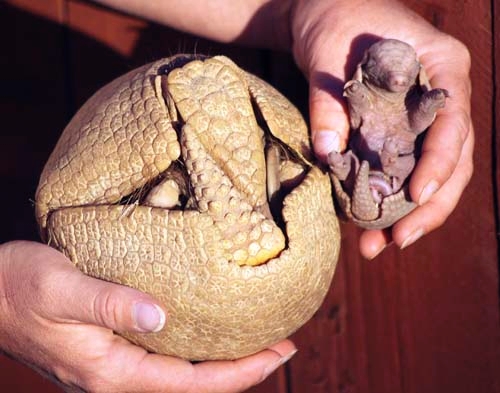Southern three-banded armadillo gives birth at Moapa zoo
He can roll up like a ball, but this baby boy doesn't exactly bounce. At just over a week old, Tuck the armadillo doesn't do much of anything yet.
The newest addition to the family-run Roos-N-More zoo in Moapa mostly sleeps and eats and huddles in his burrow.
"He's pretty inactive. He really spends most of his time cuddled up under mom," said Las Vegas veterinarian and Roos-N-More founder Valerie Holt.
Tuck is a southern three-banded armadillo, a near-threatened species of mammal native to central South America.
He is slightly larger than a golf ball and weighs about 4 ounces. His eyes and ears are still closed like a newborn kitten's, only not as cute. When he balls himself up, he resembles a cross between a space alien and plastic toy Pokémon character.
His arrival on Nov. 11 came as a complete surprise.
"I was actually the one who found him. I was jumping up and down and screaming," Holt said. "We were ecstatic to say the least."
Roos-N-More got its first three-banded armadillo, a female named Tiptoe, in April. The 3-acre zoo about 55 miles northeast of Las Vegas added a male named Tank over the summer, but Holt said they had no idea the pair would mate so quickly.
It's been an educational experience, even for two seasoned veterinarians like Holt and her husband, Jay.
Holt said one of her first thoughts when she discovered that Tiptoe had given birth was, "OK, where are the nipples on these things?"
"We've kind of learned a lot in the last few days," she said.
For example, Holt said, Tuck spends a lot of time upside down, which is apparently the best way to nurse for two animals whose backs are covered in hard armor from head to tail.
The Holts also have learned that male armadillos make pretty good parents in their own right. When Tiptoe leaves the burrow to eat, Tank takes her place so the baby doesn't get cold.
Three-banded armadillos are smaller and less-common than their nine-banded cousins in Texas and Oklahoma.
"When you roll them up into a ball, they actually kind of look like a cantaloupe," Holt said of the three-banded variety.
The insect-eater's numbers are declining in South America, mostly because of people hunting it as a delicacy. There aren't many of them in captivity, either.
According to the International Species Information System, a nonprofit group that tracks zoological data worldwide, just 15 three-banded armadillos were born in zoos around the world last year, six of them in U.S.
This is the second rare birth this year at Roos-N-More. In April, the zoo welcomed an endangered ring-tailed lemur named Marques.
Holt got her first exotic animal, a Bennett's wallaby named Pogo, as a birthday present from Jay in 2002.
Today, the Holts and their two children share their home-turned-zoo in Moapa with more than 200 animals, exotic and domestic.
Roos-N-More opens its doors to the public once a week or so. The rest of the time tours are offered by appointment only.
The zoo will be open to the public from 9 a.m. to 3 p.m. Sunday and again on Nov. 27 .
Contact reporter Henry Brean at hbrean@review journal.com or 702-383-0350.
ON THE WEB
For more information visit www.roosnmore.org


















